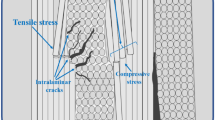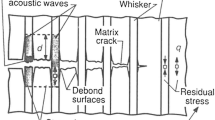Abstract
The fracture behaviour of injection moulded polyarylamide (PAR) composites containing 30, 50 and 60 wt% glass and 30 wt% carbon fibres has been investigated in both dry and wet states. Kinetics of moisture absorption study revealed that PAR and its composites exhibit Fickian behaviour. The incorporation of short fibres into a PAR matrix has resulted in the reduction of both maximum moisture content (M m ) and diffusion coefficient (D). The fracture mechanical characterization of the various materials was evaluated by using notched compact tension (CT) specimens. Testing was performed as a function of temperature (T = −40, 20 and 80°C) and crosshead speeds (v = 1 and 1000 mm min−1) on as received (AR) specimens. The influence of water uptake due to the hygrothermal ageing (HA) process on residual fracture performance was also studied. The combined action of moisture-induced plasticization of the PAR matrix and interfacial degradation has been concluded to play a significant role in controlling the fracture behaviour of the (HA) composites. The residual fracture properties of both neat PAR and its composites are almost fully recovered in the case of redrying (RD). Failure mechanisms of both the matrix and the composites, assessed by fractographic studies in a scanning electron microscope (SEM) are discussed.
Similar content being viewed by others
References
IXEF “Reinforced polyarylamide-based thermoplastic compounds”, Technical Manual, Solvay S.A, Brussels, Belgium (1989).
A. HADDOUT and G. VILLOUTINE, Composites 25 (1994) 147.
T. CZIGANY, Z. A. MOHD ISHAK and J. KARGER-KOCSIS, Appl. Compos. Mater. 2 (1995) 313.
J. KARGER-KOCSIS and K. FRIEDRICH, Compos. Sci. Technol. 32 (1988) 293.
J. KARGER-KOCSIS and K. FRIEDRICH, Plast. Rubber Compos. Process. Appl. 8 (1987) 91.
J. KARGER-KOCSIS and K. FRIEDRICH, J. Mater. Sci. 22 (1987) 947.
Z. A. MOHD ISHAK and J. P. BERRY, Polym. Compos. 15 (1994) 223.
A. C. LOOS and G. S. SPRINGER, J. Compos. Mater. 14 (1980) 143.
M. J. FOLKES, in “Short fibre reinforced thermoplastics” (Research Studies Press, Wiley, Chichester, 1982).
T. O. AHN, S. LEE, H. M. JEONG and S. W. LEE, Polymer 37 (1996) 3559.
Z. A. MOHD ISHAK and J. P. BERRY, J. Appl. Polym. Sci. 51 (1994) 2145.
Z. A. MOHD ISHAK and N. C. LIM, Polym. Eng. Sci. 34 (1994) 1645.
Z. A. MOHD ISHAK, U. S. ISHIAKU and C. P. TAN, in “Advanced New Materials and Emerging New Technologies” edited by P. N. Prasad, J. E. Mark and J. F. Tung (Plenum Publishing Corporation, New York, 1995) p. 134.
M. AKAY, Polym. Polym. Compos. 2 (1994) 349.
D. D. HUANG, Polym. Compos. 16 (1995) 10.
J. KARGER-KOCSIS, T. HARMIA and T. CZIGANY, Compos. Sci. Technol. 54 (1995) 287.
J. KARGER-KOCSIS, in “Application of Fracture Mechanics to Composite Materials”, edited by K. Friedrich (Elsevier, Armsterdam, the Netherlands, 1989) p. 189.
Author information
Authors and Affiliations
Rights and permissions
About this article
Cite this article
Mohd Ishak, Z.A., Ishiaku, U.S. & Karger-Kocsis, J. Microstructure-related fracture behaviour of injection moulded short fibre reinforced polyarylamide in dry and wet states. Journal of Materials Science 33, 3377–3389 (1998). https://doi.org/10.1023/A:1013297616391
Issue Date:
DOI: https://doi.org/10.1023/A:1013297616391




